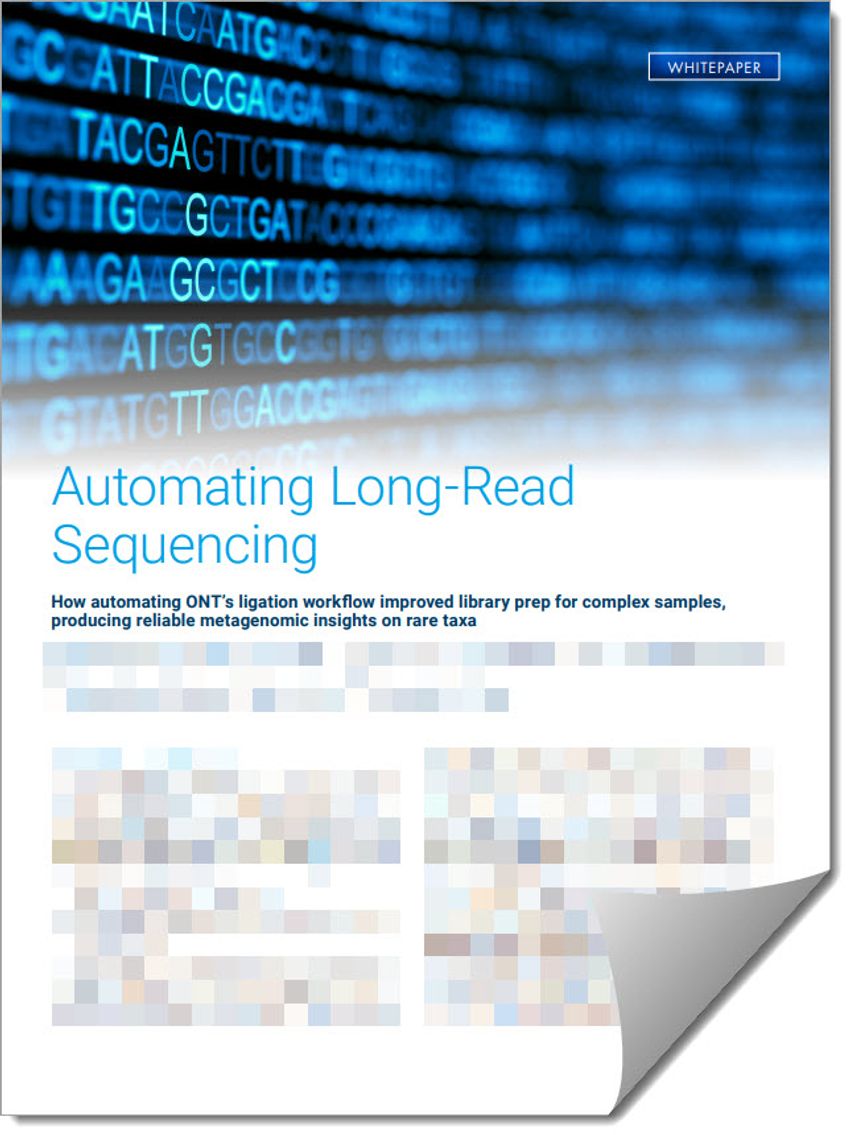Long-read sequencing (LRS) has become a transformative tool in modern genomics. Unlike short-read sequencing, which typically handles DNA fragments of only a few hundred bases, LRS can read tens of thousands of bases in a single pass. Single-molecule LRS technology can:
t Reduce amplification bias
t Detect complex structural variants
t Capture rare organisms and subtle shifts in community composition
These strengths are especially valuable in metagenomics, where complex environmental or biological samples contain diverse microbial assemblages. As with short-read sequencing, manual LRS library preparation workflows are challenging to scale. While multiplexing samples can improve throughput, it also increases protocol complexity. Multiple rounds of end repair, adapter ligation, bead cleanups, and amplification steps create opportunities for human error, sample loss, and variability between runs.
Automating library preparation is a popular solution to these pain points for high-throughput short-read sequencing—improving pipetting accuracy and precision increases consistency and reproducibility of sequencing results, enabling labs to scale up sequencing projects with confidence.
Automating LRS library preparation for metagenomic analysis presents additional considerations, however. A case study comparing microbial communities in soil demonstrates successful automation of the Oxford Nanopore Technologies’ (ONT) General Ligation LSK114 workflow on the Agilent Bravo NGS workstation (Figure 1). It highlights the technical challenges, operational gains, and broader lessons for lab managers.
The challenge: Why long-read automation is different
Automation has become routine in short-read sequencing, but long-read workflows introduce additional hurdles. Long DNA fragments are more prone to shearing during transfers and mixing. Recovery during bead cleanup protocols is often lower than for short fragments, risking reduced yield. Intricate workflows with multiple stages of repair, ligation, and amplification require precise coordination to avoid compounding variability and careful handling to avoid fragment damage. Meeting these demands while increasing throughput requires carefully balanced protocols and flexible automation software.
Automating ONT’s general ligation workflow
To test the robustness of automation in real-world conditions, the research team used soil-derived DNA samples from a wide range of habitats with different geochemical traits. This introduced natural variability into the test system to assess whether automation could deliver consistent outcomes.
Workflow design
Libraries were prepared using the ONT General Ligation LSK114 kit with Agilent’s VWorks control software (Figure 2) and Bravo NGS workstation. Modular runsets enabled more complete automation of sensitive and labor-intensive workflow steps. Combined end repair and adapter ligation steps with on-deck bead cleanup, enabling walkaway automation both pre- and post-library pooling. Barcoding PCR setup and cleanup were handled with separate protocols, with amplification carried out off-deck. Library pooling was also automated, with a normalization and pooling module that imported sample volumes and locations from a CSV file. Importantly, the platform allowed runs of anywhere from eight to ninety-six samples, making it possible to scale throughput to project needs without reprogramming protocols (Table 1).
Table 1. Protocol run times for individual steps of automated General Ligation LSK114.
Workflow step Walk away time
End repair and cleanup 53 minutes
Ligation and cleanup 63 minutes
Barcoding PCR 8 minutes
Barcoding cleanup 33 minutes
Figure 2. Agilent VWorks automation control software protocol form.
Demonstrating reliability across diverse samples
The automation workflow yielded a high recovery of DNA. Optimizing bead cleanup mixing cycles was especially important; with 60 cycles, the team achieved recovery rates averaging around 90 percent after end repair and cleanup. Post-adapter ligation and PCR cleanup used a lower DNA-to-bead ratio and averaged 79 percent recovery, reflecting the additional challenges of long-fragment processing but still providing strong yields compared to expectations (Figure 3).
Figure 3. Optimized recovery rates for standalone automated bead cleanups, performed using DNA standards.
All 24 soil samples generated high-quality sequencing libraries regardless of their source (Table 2). Quality control of prepared libraries, performed on an Agilent TapeStation 4200 system, showed high-molecular-weight libraries with a maximum peak size of just over 7 kb. Sequencing quality scores (Q20 and Q30) were stable across samples, with only modest variation in read lengths depending on soil type.
For example, N50 values ranged from roughly 2,984 base pairs in pasture soils to nearly 3,900 base pairs in heath soils, demonstrating that sample origin, rather than workflow variability, accounted for most differences (Figure 4).
Table 2: Mean sequencing metrics of the 24 libraries comparing DNA sampling sites.
Sample source Heath Pasture Woodland Arable
Sample numbers 8 6 4 6
N50 3887.3 2984.0 3575.5 3347.5
Q20 (%) 79.5 79.3 79.5 79.8
Q30 (%) 62.8 62.5 62.7 63.2
GC (%) 57.1 53.8 56.9 57.0
Classified (%) 15.7 23.2 17.4 23.6
Classified reads 151980 321539 217344 178383
Taxonomic classification identified more than 24 microbial families across the samples (Figures 5 and 6), including rare taxa that might otherwise have been overlooked.
Bray-Curtis ecological analysis further demonstrated that soil type explained the majority of differences in microbial community composition, validating the workflow’s ability to preserve biological signals through technical processing that is necessary for meaningful ecological interpretation.
Figure 4. Quality control images comparing pooled libraries prepared manually versus using Agilent Bravo NGS library preparation, analyzed by the Agilent TapeStation 4200 system.
Figure 5. Histogram plot showing the read length distribution of the 24 pooled libraries.
Figure 6. Relative abundance of microbial families across the four soil types.
Operational impacts for the lab
For lab managers, the value of this study extends beyond the technical success to demonstrate the impact of automation on reproducibility, scalability, and efficiency in LRS workflows:
• Reproducibility: Automated liquid handling reduced variability between runs, critical for comparing datasets across time, geography, or projects.
• Throughput: Parallel processing of up to 96 samples increased efficiency without proportional increases in staff time.
For Research Use Only. Not for use in diagnostic procedures.
• Walkaway time: On-deck incubations allowed researchers to focus on analysis and interpretation rather than repetitive manual steps.
• Resource efficiency: Optimized deck layouts minimized dead volume, conserving reagents and reducing costs.
A scalable path to confident metagenomics
This case study demonstrates how automation of single-molecule LRS library preparation can produce high-quality sequencing libraries with improved reproducibility and efficiency in metagenomic research. For labs managing complex, high-throughput sequencing projects, automation provides an operational pathway to scale up sequencing capacity without increasing costs or variability.
As sequencing continues to play an expanding role in environmental science, medicine, and industry, the ability to automate complex workflows will be a defining factor in which labs can keep pace. By reducing the barriers of manual preparation while enhancing reproducibility, automation represents both a technical solution to workflow challenges and a strategic advantage for labs seeking to lead in the genomic era.
Reference
1. Sabale, S.; Suryawanshi, P.; Krishnaraj, P. U. Soil Metagenomics: Concepts and Applications. Metagenomics - Basics, Methods and Applications. 2020.
How Automation Impacts Reproducibility in Genomics
Reproducibility is a recurring challenge in sequencing labs, particularly in long-read single-molecule sequencing, where sample handling can make or break success. Automation contributes to reproducibility in several ways:
• Precision liquid handling: Reduces variability in pipetting volumes that can alter yields.
• Standardized timing: Incubation and cleanup steps are performed with consistent intervals, reducing protocol drift between users.
• Gentle handling: Optimized mixing cycles reduce shear forces that damage long molecules.
• Error minimization: Fewer manual interventions mean fewer opportunities for mislabeling, contamination, or skipped steps.
• Cross-run consistency: Standardized workflows enable comparisons across large datasets, essential for metagenomic studies and clinical research.
In the context of single-molecule sequencing, where every intact fragment carries valuable biological information, reproducibility underpins the scientific validity of results.
Checklist: Five Questions to Ask Before Automating Your Sequencing Workflow
1.What are our current bottlenecks?
Identify whether time, error rates, or staff workload are the primary drivers for automation.
2.Can our samples tolerate automated handling?
Consider DNA fragility, recovery rates, and whether automation protocols align with your input materials.
3.What level of throughput do we need?
Balance flexibility with capacity—avoid over-investing in systems that exceed or fall short of project requirements.
4.How will automation impact reproducibility?
Evaluate whether standardization of workflows will improve data comparability across runs or collaborative projects.
5.What is the long-term ROI?
Factor in reagent savings, reduced error correction, and staff time when justifying automation investments.





